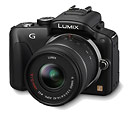 Panasonic has upped-the ante in the Compact System Camera arena with the smallest EVF-equipped (electronic viewfinder) Micro Four Thirds camera yet. The new Panasonic Lumix DMC-G3 has a built-in electronic viewfinder but is only about half an inch taller and wider than their LCD-only GF3 Micro Four Thirds camera. However, it’s not really that much smaller than the original G1 (announced in 2008) – they’ve chopped about half an inch from the width but height and depth are basically the same. On the other hand, for the EVIL / Compact System Camera class, smaller is always going to be better. So props to Panasonic for cramming the EVF into an even smaller camera body.
Panasonic has upped-the ante in the Compact System Camera arena with the smallest EVF-equipped (electronic viewfinder) Micro Four Thirds camera yet. The new Panasonic Lumix DMC-G3 has a built-in electronic viewfinder but is only about half an inch taller and wider than their LCD-only GF3 Micro Four Thirds camera. However, it’s not really that much smaller than the original G1 (announced in 2008) – they’ve chopped about half an inch from the width but height and depth are basically the same. On the other hand, for the EVIL / Compact System Camera class, smaller is always going to be better. So props to Panasonic for cramming the EVF into an even smaller camera body.
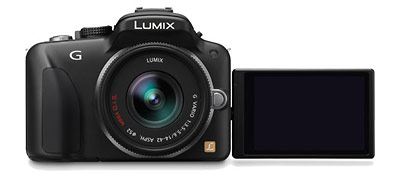
Panasonic can use the superlative, “smallest,” when describing the new G3. But really, that’s mostly marketing. There’s actually a lot more to the Panasonic G3 and I think the other stuff is a bigger deal. The official press release was dense with specs and features. I took a lot of notes and boiled it all down to what I think really sets the G3 apart from the competition. Let’s get started with the basics:
Panasonic Lumix G3 Key Features and Specs:
- New 16-megapixel Live MOS sensor
- 1920 x 1080 AVCHD full HD video with stereo sound
- 3-inch 460k-dot touch-control tilt-swivel LCD
- Faster, more precise, touch-control auto focus
- Improved noise control: 66% less noise in general and 200% at high ISO compared to the previous, 12-megapixel sensor
- New iA Plus shooting mode offers beginner-friendly touch-screen-slider-enabled manual controls
- Built-in EVF (electronic viewfinder)
- 4 frames-per-second burst at full resolution and 20 frames-per-second at 4-megapixels
- Creative Control mode with Retro, High Key, Sepia and High Dynamic effects
Now, lets take a look at what really makes the Panasonic Lumix G3 special:
Of the features and specs I listed above, I’m most interested in the improved noise control from the new sensor / processor combo, the improved auto focus and the touch-control LCD display. I’ve only used the 12-megapixel sensor Micro Four Thirds cameras. They have great image quality, although it’s not as good as most current digital SLRs. Last fall Panasonic announced the GH2 with a new 16-megapixel sensor. I’m not sure how the new G3′s a6-megapixel sensor is different but Panasonic clearly calls it a “new” sensor in the official press release. Regardless of whether it’s really different from the GH2 sensor, I’m anxious to see how they’ve improved on the image quality of the 12-megapixel Micro Four Thirds cameras. The press release says the new sensor, in conjunction with the Venus Engine FHD image processor, uses “selective noise reduction to create a more naturally-balanced curve without deterioration of the image.” They also say the G3 has 66% lower noise and 200% lower noise at high ISO. That sounds great, although I need to actually take my own pictures and evaluate with my own eyes to find out what that really means. Too often, lower noise is at the expense of sharpness and detail. One of the main criticisms aimed at the Olympus and Panasonic Micro Four Thirds format cameras is that the smaller sensor (compared to APS-C digital SLRs and compact system cameras) is a serious image quality limitation. Personally, I have no complaints about the image quality from the 12-megapixel Micro Four Thirds cameras. Even if it’s not as good as current digital SLRs, it’s way better than even the best compact digital camera and in a package much smaller than any DSLR. If Panasonic has, in fact, managed to increase resolution, noticeably reduce noise and retain critical detail, I will be very pleased!
In my opinion, the biggest limitation to using Micro Four Thirds cameras like the new Panasonic Lumix G3 has been the auto focus performance. I’m primarily an outdoor sports shooter and I’d love a really compact camera system with serious auto focus performance. So far, the Olympus and Panasonic Micro Four Thirds cameras perform like high-end compact cameras as far as auto focus goes. That makes them great for landscape and subjects where you can pre-focus. But for more unpredictable, moving subjects like sports, little kids and pets, they just don’t cut the mustard. So it’s exciting to see Panasonic addressing this with their new “Precision Contrast LightSpeed AF” system. They’ve increased the “Live MOS Sensor drives speed from 60 fps to 120 fps” to achieve an auto focus detection time of, “approximately 0.1 second.” I’ll have to actually use the camera in the field to find out if there’s a real, practical performance improvement. It sure sounds good, though. And I’m happy that Panasonic is giving some attention to what is arguably the Achilles Heel of the Micro Four Thirds and other Compact System Cameras.
Panasonic introduced the touch screen LCD display to their Micro Four Thirds cameras with the Lumix GH2, I believe. I haven’t had the chance to try one of their touch screen cameras yet but I’m very curious. One of the ways they’ve made the touch screen more than just a gimmick is, “Touch auto focus”, where you focus simply by touching your subject on the LCD screen. The camera then focuses on and tracks the subject as it moves. That’s pretty sweet! Panasonic is introducing a new a new touch screen-related feature on the G3. “Pinpoint AF” allows, “near-pixel-level focus point setting at the touch of a finger.” Even with the best digital SLRs, accurate selective focus can be difficult. More times than I care to remember, I’ve come home and discovered a carefully composed mountain bike photo wasn’t focused quite as I intended. Pinpoint AF sounds like a great new feature that could offer real photo quality improvement.
Compact System Cameras have come a long way since Panasonic introduced the first Micro Four Thirds camera, the G1, back in 2008. The G1 was a pretty straightforward still camera compared to the full HD video, touch screen cameras Panasonic is making now. Although the new G3 isn’t really that much smaller than the original G1, it’s a hell of a camera when you consider how much more it does and how much better it does it. The Panasonic Lumix G3 should be available in stores next month (June, 2011) for about $699 with the 14-42mm f/3.5-5.6 image-stabilized kit lens. The G3 will be available in black, red, white and brown.
Panasonic Lumix G3 Press Release >>
Related Content:
All Panasonic Digital Camera User Reviews
All Digital Camera User Reviews
EVIL & Micro Four Thirds Cameras Forum
More Panasonic Camera News
Panasonic Digital Cameras Web Site
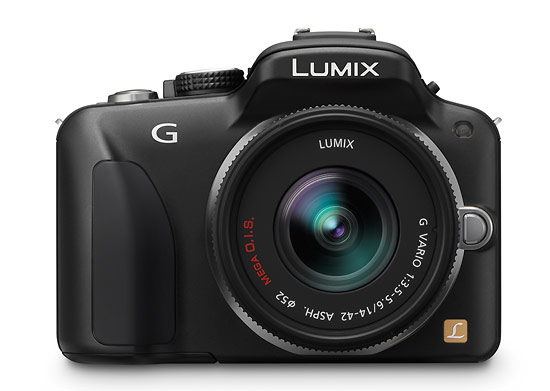
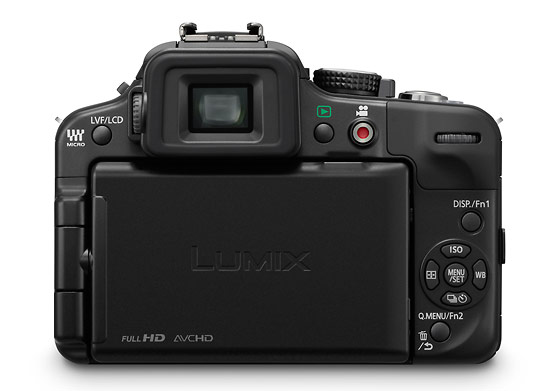
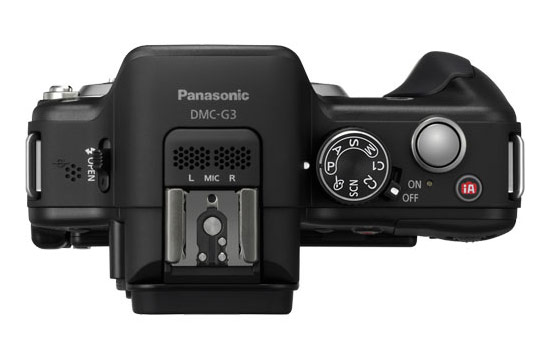


“So far, the Olympus and Panasonic Micro Four Thirds cameras perform like high-end compact cameras as far as auto focus goes. That makes them great for landscape and subjects where you can pre-focus. But for more unpredictable, moving subjects like sports, little kids and pets, they just don’t cut the mustard”
I can’t believe you wrote that John. Not because it is your website you just write anything, it has to make sense. You cannot use micro four thirds to shoot kids and pets?. Lets both have a look at your gallery and mine, will you?.
Thanks for the comment, Asmarlak. Yes, you;re right. I have taken a lot of photos of subjects in action with Micro Four Thirds cameras. However, my technique options are limited because of the poor continuous auto focus performance. I also have a lot of experience. The avreage person looking at these cameras won’t have my experience and technique. Those are the people I’m writing to there. Yes, you can capture action if you can predict it and pre-focius. But continuous auto focus for unpredictable, fast-moving subjects is pretty much out of the question. For that, you need a digital SLR with Phase Detect auto focus. At least, that’s been my experience. I am curious to see how much Panasonic has improved the auto focus with this camera. They’ve got my attention.
Sorry man, I don’t take your word for it. the sites I trust with their reviews PR is not one of them. I’m here only for the Gallery.
Well, that was condescending.
If you’re saying you think I don’t know what I’m talking about, you should consider that I’m a regularly published action sports photographer, I get a chance to use all kinds of cameras and I push them all pretty hard – harder than most other camera reviewers. The comments you’re taking exception to here are about compact system cameras with contrast detect auto focus, in general. And they are based on lots of hands-on experience with 6 or 7 difference cameras, in the field, with skiers, mountain bikers and other subjects. For what it’s worth, when I take a Micro Four Thirds camera out on the trail or on skis it’s a conscious compromise for weight and space and I know I won’t be able to get as many keepers or shoot the way I like. If I have an important, paying action photography job, I won’t shoot it with a Micro Four Thirds camera because usable continuous auto focus is so important. I love Micro Four Thirds for travel, people and landscape photography. But like I said in the article, for action, it doesn’t cut the mustard. Yet.
Sorry you don’t care for my reviews. I put a lot of effort into them and try to be fair and honest. Let me pioint out that this article is not actually a review. It’s an analytical announcement article based on my experience with other cameras and the information provided by Panasonic. If and when I actually review the Panasonic G3, I may have very different things to say.
I guess if you cannot shoot kids and pets with micro four thirds systems. Then I have to take your word for it also that you cannot do it either with point and shoot cameras?. I can see what your limitations really are.
John, I think you should be very careful in what you write. By saying that a whole system is not suitable for shooting kids and pets, you’re telling more than half of new camera buyers not to buy it.. Also to put kids and pets in the same category as Car races skiing, and horse riding is just flat out wrong.
I for one am excited to try out the G3. I own a G1 and have found that the auto focus is quite good for contrast detection cameras, but I agree with John that I cannot get the same shots that I can with a much better DSLR setup. I regularly shoot league softball games with my G1 and a 30 yr old Tokina 70-210mm f4 MF lens via 4/3 adapter. It’s all manual focus, but I have to pre-focus to get the shots. When I use the 14-45mm AF lens, it does OK, but even with the focus tracking feature it can’t keep up with the fast motion. Kids in general it can do, but a runner at home plate it lacks a little… With the Nikon D700 and 80-400mm VR lens I can get awesome shots in perfect focus at something like 6 fps??? There’s about a $4500 difference in price there too though… If it came down to buying another camera, I want to go Nikon DSLR, but there’s something about the Lumix G line that keeps me thinking twice about regular DSLR’s anymore…
If it came down to buying another camera, I want to go Nikon DSLR, but there’s something about the Lumix G line that keeps me thinking twice about regular DSLR’s anymore…
I’ve been thinking about Asmarlak’s comments for a while now. I still disagree and believe he’s missing the point. That said, I’ve been thinking more about shooting action with Micro Four Thirds and other mirrorless cameras and I just made a post about it on our EVIL & Micro Four Thirds Forum: http://forums.photographyreview.com/showthread.php?t=77015
I got a G-1 couple of months after it came out and I have used it when I didnot want to use my Nikons. The G-1 preformance has always been very good and I have gotten some very good pic. I have used it at “Living Histories” and tacticle demonstration where there is a lot of unpredictable and sudden movements. The G-1 has produced some very good images, a little soft, and sometimes not as sharp as I would like, but still quite good images. The only complaint I really have is the little long lag time between the time when the shutter button is pressed and when the picture is taken. But once I learned to adapted myself to that Shooting pictures of people and children and animals during moving and playing at the living histories and playgroungs are surprising good, but still I have to really work at getting real good shots.
V/R
Jim Budd